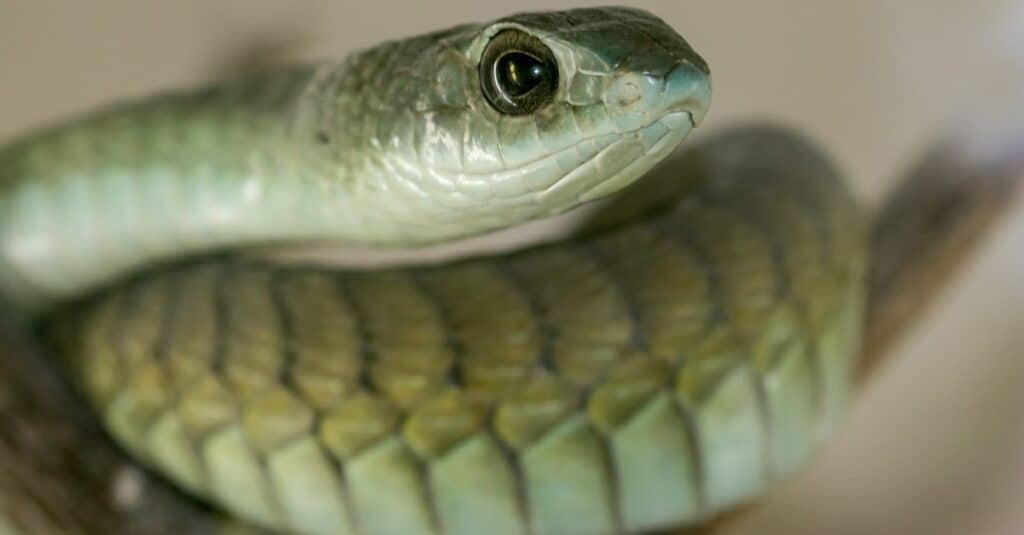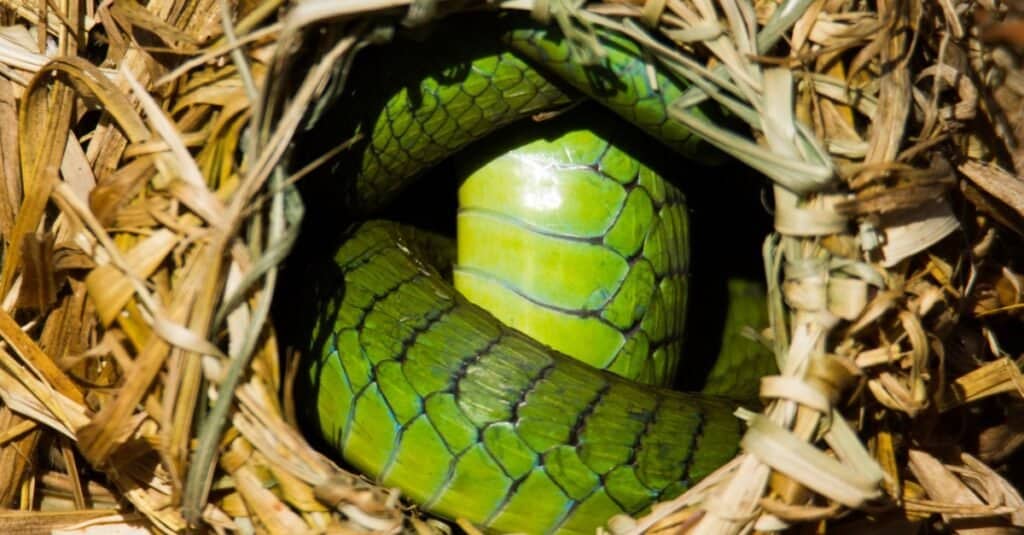Boomslang
.jumbotron {
background-image: url(“https://a-z-animals.com/media/2022/01/boomslang3-400×300.jpg”);
}
}
@media only screen and (min-width: 641px) and (max-width: 920px) {
.jumbotron {
background-image: url(“https://a-z-animals.com/media/2022/01/boomslang3-470×370.jpg”);
}
}
@media only screen and (min-width: 921px) {
.jumbotron {
background-image: url(“https://a-z-animals.com/media/2022/01/boomslang3.jpg”);
}
}
Boomslang
Dispholidus typus
Boomslang Scientific Classification
- Kingdom
- Animalia
- Phylum
- Chordata
- Class
- Reptilia
- Order
- Squamata
- Family
- Colubridae
- Genus
- Dispholidus
- Scientific Name
- Dispholidus typus
Read our Complete Guide to Classification of Animals.
Boomslang Conservation Status
Boomslang Facts
This post may contain affiliate links to our partners like Chewy, Amazon, and others. Purchasing through these helps us further the A-Z Animals mission to educate about the world’s species..

Spiders that fly! Fish that walk! And 1000+ more incredible animals. Discover them all for FREE
.photo-gallery {
–margin: 0px auto 0px;
–padding: 0px 0px 0px 0px;
}
.gallery-link {
background-image: url(“https://a-z-animals.com/media/2022/01/boomslang-1024×535.jpg”);
background-repeat: no-repeat;
background-size: cover;
background-position: center;
height: 500px;
justify-content: center;
text-align: center;
align-items: center;
display: flex;
border: 2px solid #000;
}
.gallery-link img {
height: 50%;
}
@media only screen and (max-width: 768px) {
.gallery-link {
height: 300px !important;
}
}
View all of the Boomslang images!
“Clothed in striking green colors, the boomslang glides elegantly between low-lying trees in search of food and shelter.”
This reptile has perhaps one of the most unusual and fun-sounding names in the entire animal kingdom. Boomslang means tree snake in Afrikaans and Dutch. They are some of the most common venomous snakes in Africa. But because their bite can sometimes result in death, victims should always seek treatment immediately. This article will cover some fascinating facts about the identification, diet, habitat, and predators of the boomslang.
5 Incredible Boomslang Facts!
- Boomslangs have a poor sense of smell, but they have the ability to sense chemicals in the air. They will flick out their tongues to gather odor molecules and then press them against the sensory organs in the mouth.
- Noted herpetologist Karl Patterson Schmidt died from a boomslang bite in 1957 on the mistaken assumption that it would not be fatal. He documented the effects of the symptoms right up until the end.
- When the fangs are unused, the snake has the ability to fold them back into its mouth.
- Once impregnated, the female will deposit her eggs in hollow tree trunks or rotting logs somewhere close to the ground. The eggs take about three months to fully incubate and hatch.
- Although it lives in warmer climates, the boomslang will find a bird nest to hibernate in during the colder months of the year. The technical term for this dormancy period is actually brumation. When the snake is in this state, it can go for long periods of time without food.
Where to Find Boomslangs
Boomslangs are found in many different locations all across wooded grasslands and lowland forests throughout sub-Saharan Africa. Swaziland, Namibia, Zimbabwe, and Mozambique are the most common countries in which they’re found. They spend most of the day moving between the branches of trees to hunt, rest, and sleep. As a reptile, of course, they need plenty of direct sunlight to stay warm. When they need to come down to the ground, they generally do not stray very far from the tree and hide wherever they can.
Scientific Name
The scientific name of the boomslang is Dispholidus typus. Typus comes from an ancient Greek word meaning mark or impression. The boomslang is the only surviving species in its genus, but the family of Colubridae is an incredibly diverse group that includes both venomous and non-venomous snakes. There are three recognized subspecies of boomslang spread throughout the massive continent of Africa.
Population & Conservation Status
According to the IUNC Red List, the boomslang is considered to be a species of least concern. Because they’re so elusive, we don’t have a lot of specific facts about their population numbers, but they appear to be numerous and widespread.
Appearance and Description
The boomslang has a very distinctive appearance that should make identification easy. It is characterized by a long, slender body, measuring up to six feet long in size, with big eyes and an egg-shaped head. In terms of color, the two sexes look very different from each other. The females have dark green bodies and brown bellies, whereas the males have bright green bodies with black or blue outlines traced along with the scales (although yellow and brown variations have also been identified as well). These color schemes are important adaptations that provide camouflage among the trees. Young snakes are born with gray skin with yellow throats and black spots. They do not achieve their adult coloration until they reach full maturity.
How to identify the boomslang:
- Greenish-brown female, bright green male with black or blue outlines
- Long, slender body measuring anywhere between three and six feet in size
- Big black eyes
- Rounded egg-shaped head
- Big fangs near the back of the mouth
Pictures

iStock.com/Ken Griffiths

iStock.com/Kiko Janneman

iStock.com/FroeMic
Venom: How Dangerous Are They?
Boomslangs have some of the most potent venoms among the entire group of rear-fanged snakes. When injected, the venom will attack the body’s circulatory system and stop its ability to clot blood properly. Many victims simply bleed to death both internally and externally. Because it acts so slowly on people, the venom is intended as an offensive capability against smaller animals instead of a defensive measure against larger ones. When threatened by predators, they instead can widen their necks and open their mouths to appear larger. They also secrete a foul-smelling substance.
Behavior and Humans
Despite its highly toxic venom, the boomslang is a fairly timid snake. They spend most of their lives in trees and do not generally strike out at people except as a last resort. Most attacks come when they are directly handled by a person (though they do not give a warning sign before striking). Symptoms will usually begin several hours after the venom is delivered, but the victim usually survives when proper treatment is given. If one does not receive proper treatment in time, then there is a chance that the venom could prove to be fatal.
View all 192 animals that start with B
Boomslang FAQs (Frequently Asked Questions)
What is a boomslang?
A boomslang is a type of rear-fanged venomous snake. This means the location of the fangs is in the back of the upper jaw instead of the front like most venomous snakes. It must open its jaws very wide to strike at prey. Their bright green or brown skin with black markings should help with identification. Some snakes can reach more than 6 feet in size.
While fearsome in their own right, these snakes are vulnerable to attack from large carnivorous birds such as falcons, kestrels, and ospreys. These are among the few animals that can reach the boomslang in its natural arboreal habitat. The lifespan of the boomslang has never been accurately documented in the wild, but they have been observed to live some eight or nine years in captivity thanks to the absence of predators. The lifespan is often cut short by the early deaths of juveniles.
Are boomslangs venomous?
Yes, boomslangs are highly venomous snakes. They should never be disturbed or approached, especially in wild locations.
How do boomslangs hunt?
Boomslangs will find a good hunting spot in a tree and then ambush its prey in a sudden strike. The green or brown skin provides camouflage so it’s difficult to see.
Are boomslangs aggressive?
Boomslangs are not particularly aggressive toward animals larger than themselves. They will tend to strike only when handled. It would otherwise prefer to run away and hide.
Where do boomslangs live?
Boomslangs hunt, breed, and sleep in trees throughout the natural forest and grassland habitats of sub-Saharan Africa.
What do boomslangs eat?
The boomslang’s normal diet consists of lizards, frogs, birds, eggs, rodents, and other small mammals. Sometimes they will even cannibalize each other when there isn’t enough food around. They have the ability to open their mouths about 170 degrees wide and then swallow the prey whole.
Can a boomslang climb a wall?
This snake does have the ability to ascend many different vertical surfaces, although it depends on the height and the texture of the wall.
Can a boomslang swim?
This snake does not normally venture close to large bodies of water, but there is some evidence to suggest it can swim for at least short periods of time.
What do I do if a boomslang bites me?
If a boomslang bites you, then you should immediately seek medical attention. Most people should survive with few long-term complications after they receive sufficient treatment. Fortunately, the venom is quite slow-acting on people. You will have at least several hours before you begin experiencing symptoms. But do not take the initial lack of symptoms as a sign that you are okay. An untreated bite can still lead to death in a small number of cases. It can also be quite an agonizing experience.
How long does it take for a boomslang to kill you?
It may take at least a day or two before the venom reaches its full effect and kills a person.
What is the difference between a black mamba and a boomslang?
The key differences between a boomslang and a black mamba are appearance, distribution, species, prey, and predator. Typically, a black mamba is shorter than a boomslang. While boomslangs belong to the Colubridae family, black mambas belong to the Elapidae family.
What are the differences between a green mamba and a boomslang?
The key differences between green mambas and boomslangs lie in their size, appearance, color, and venom. Green mambas are generally heavier, longer, and deadlier than boomslangs.
What is the difference between an inland taipan and a boomslang?
The key differences between a boomslang and an inland taipan lie in their distribution, habitat, size, morphology, and venom. The former has a predilection for wooded grasslands and lowland forests in Africa, while the latter is predominant in near-desert areas in Australia. Furthermore, inland taipans are generally larger than boomslangs.
What is the difference between a king cobra and a boomslang?
Size, phylogenic families, distribution, morphology, reproduction, life cycle, and conservation status are the key differences between a boomslang and a king cobra. First, the average king cobra can grow thrice as long as the average boomslang. Furthermore, boomslangs are found in Africa, while king cobras are well distributed in Southeast Asia.
What is the difference between a boomslang and a spotted bush snake?
The most striking difference between a boomslang and a spotted bush snake is size, morphology, and behavior.
Sources
- Animal Diversity Web, Available here: https://animaldiversity.org/accounts/Dispholidus_typus/
















